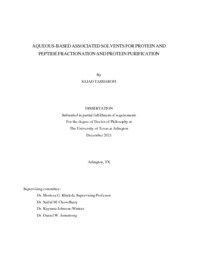
ATTENTION: The works hosted here are being migrated to a new repository that will consolidate resources, improve discoverability, and better show UTA's research impact on the global community. We will update authors as the migration progresses. Please see MavMatrix for more information.
Show simple item record
| dc.contributor.advisor | Chowdhury, Saiful M | |
| dc.creator | Tasharofi, Sajad | |
| dc.date.accessioned | 2023-06-28T17:18:32Z | |
| dc.date.available | 2023-06-28T17:18:32Z | |
| dc.date.created | 2021-12 | |
| dc.date.issued | 2022-01-03 | |
| dc.date.submitted | December 2021 | |
| dc.identifier.uri | http://hdl.handle.net/10106/31402 | |
| dc.description.abstract | The focus of this dissertation is studying capabilities of a novel two-phase system in enhancing protein identification in the whole-cell proteomics studies. In this document, two types of biphasic systems have been used for two different purposes.
The first type of biphasic system is formed by the addition of 1,1,1,3,3,3-Hexafluoro-2-propanol (HFIP) to the aqueous solutions of water-miscible organic solvents. A combination of HFIP, organic solvent, and water forms a two-phase system in spite of the fact that every solvent pair in the three-component system is miscible and forms homogeneous solutions in water. This biphasic system is called Fluoroalcohol-Organic Associated Solvent (FOAS) system. This system is used for fractionation of tryptic digest peptide mixture from yeast proteome. This fractionation is shown to be very effective in various aspects of proteomics workflow such as identification of low abundance proteins, improved identification of α-helix structures and identification of proteins with post translational modifications (PTMs).
The second type of fluoroalcohol mediated biphasic system involves the use of surfactants as the amphiphile instead of an organic solvent. These systems are called Fluoroalcohol Induced Coacervate (FAiC) biphasic systems. The FAiC systems are used to fractionate yeast proteome or yeast proteins before digestion. Fractionation of proteins in this system is shown to be effective in improving identification of low abundance proteins and proteins with α-helix structures. The FAiC systems in this study are composed of of a mixture of an anionic and and a cationic amphiphile. The relative mole ratio of the anionic and cationic amphiphile determines the charge of the coacervate phase that influences protein fractionation patterns through electrostatic interaction.
As mentioned earlier, in both biphasic systems, identification of α-helix proteins studied. Determination of secondary structure of proteins is not a trivial task. There are few experiment methods available to determine the secondary structure of proteins, but the demand is exceeding the capacities of those experimental methods to provide an answer. Computational tools have been developed to determine the secondary structure of proteins. One of the most advanced methods in terms of accuracy of prediction, is NetSurP-2.0. This tool predicts secondary structure of proteins with accuracy of 85% but it is not designed to process large number of peptides and provide a coherent picture of secondary structure of proteins corresponding to those peptides. A tool developed as an extension to NetSurP-2.0 that can process large number of peptides form bottom-up proteomics and calculates the percent coverage of secondary structures of the proteins involved in the study; this tool is named yeast proteome secondary structure calculator (ypssc) In collaboration with developers of NetSurP-2.0, we analyzed whole yeast proteome in NetSurP-2.0 and created a database for secondary structures of yeast proteins. The tool we developed, ypssc, uses this database to find secondary structures of peptides and proteins identified in the sample. Without ypssc, the task of secondary structure identification form bottom-up proteomics would be almost impossible, however, ypssc enables the user to process a large bottom-up proteomics data (like the proteomics studies that mentioned earlier) in less than 1 min in a regular desktop computer. ypssc is written in R language, and it is part of Comprehensive R Archive Network (CRAN) as a package which enables the user to use this advanced tool with no knowledge of programming.
In another project, the use of FOAS systems or desalting proteins solutions is demonstrated. The FOAS biphasic systems consist of an organic-rich bottom phase (HFIP- Organic Associate Solvent) and an aqueous-rich top phase. This unique characteristic makes FOAS suitable for desalting proteins solutions especially in the top-down studies that analyzes proteins via direct infusion to mass spectrometers. Results show that proteins, even very hydrophilic ones, are extracted in the organic bottom phase and salts in the sample are almost entirely extracted to the top aqueous phase. Experimental results show successful desalting of 3 proteins form 5 different salts. | |
| dc.format.mimetype | application/pdf | |
| dc.language.iso | en_US | |
| dc.subject | Bottom-up proteomics | |
| dc.subject | Secondary structure of proteins | |
| dc.subject | Protein desalting | |
| dc.title | AQUEOUS-BASED ASSOCIATED SOLVENTS FOR PROTEIN AND PEPTIDE FRACTIONATION AND PROTEIN PURIFICATION | |
| dc.type | Thesis | |
| dc.date.updated | 2023-06-28T17:18:32Z | |
| thesis.degree.department | Chemistry and Biochemistry | |
| thesis.degree.grantor | The University of Texas at Arlington | |
| thesis.degree.level | Doctoral | |
| thesis.degree.name | Doctor of Philosophy in Chemistry | |
| dc.type.material | text | |
| local.embargo.terms | 2023-12-01 | |
| local.embargo.lift | 2023-12-01 | |
Files in this item
- Name:
- TASHAROFI-DISSERTATION-2021.pdf
- Size:
- 7.583Mb
- Format:
- PDF
This item appears in the following Collection(s)
Show simple item record


